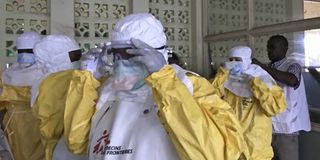DR Congo seeks to defeat Ebola with digital tool from a Tanzanian University

Morogoro. In efforts to combat Ebola, the Democratic Republic of Congo (DRC) is seeking to borrow Afya Data, a disease surveillance digital application, from Tanzania that was developed at Sokoine University of Agriculture (SUA).
The App, which was launched yesterday in Morogoro, works by empowering people in communities to use mobile phones to report any suspected cases of people who might have come in contact with infectious diseases such as Ebola, Rift Valley Fever and Marburg. Cholera outbreaks can also be reported at the earliest stage. Prof Esron Karimuribo, a researcher from the Disease-Outbreak Detection and Response in East and Southern Africa (DODRES) based at SUA, revealed that the DRC had expressed intention to secure the App in an effort to deal with the outbreak of Ebola that has so far claimed 27 lives. Prof Karimuribo revealed this during the launch of the App at SUA where government officials and experts from various research organisations teamed up to discuss how they could use it to combat epidemics which have, for many years, affected communities in Tanzania.
“We are looking into how to work with the DRC. When all procedures are finalised, we expect to send a team of experts to the Ebola-hit country so that they can apply the App. This will have been SUA’s contribution in fighting epidemics such as Ebola,’’ he said.
The App, dubbed AfyaData, is a set of open source mobile and web digital tools developed by the Southern African Centre for Infectious Diseases Surveillance (SACIDS) which is based at SUA.
The App, which can be downloaded for free via Google play store, works to empower communities to participate in combating diseases that can be transmitted from animals to humans.
How it works
People in communities can use AfyaData by collecting data on signs and symptoms via an android App sent over the internet to a server where they are stored, synthesized, analyzed and intelligently translated by medical experts into a diagnosis. This information can be used to provide feedback to authorities who can then take action in combating potential threats.
It provides details of location via GPS and can also avail data on the extent of the problem, depending on the amount of details that people in communities can feed into the app.
So far, over 400 community reporters and researchers have already joined a network of people who are applying the App in five districts of the country: Ulanga, Kibaha, Malinyi, Kilosa and Ngorongoro. It is now in phase II of its implementation.
SUA Vice Chancellor, Prof Raphael Chibuda, said the new App came as part of the varsity’s contribution to the country’s preparedness to combat life-threatening epidemics such as Rift Valley Fever, Ebola and other diseases that could spread from animals to humans.
To develop the App, the researchers secured a $450,000 funding from US-based Ending Pandemics. The technology was developed by a team of animal, human and ICT specialists.
Uganda, Kenya and Thailand have also expressed their intention to import the technology, revealed the SUA VC.
The executive director of the Southern African Centre for Infectious Disease Surveillance (SACIDS), Prof Mark Rweyemamu, said Tanzania was now better placed to detect infectious diseases using the app because of its political set up.
“The presence of village governments means that leaders can mobilise communities to fight epidemics at grassroots level,’’ he said.
SACIDS communications expert Yunus Krsani said diseases which could potentially turn into an outbreak could now be reported more easily and accurately with the App.
“For instance, if one person reports a case of profuse diarrhoea and vomiting in humans, it may not trigger an outbreak alert. But if we receive five such cases from the same area through a community health worker this maybe an indication of an outbreak,’’ he said.
“The system may deduce the most probable diagnosis, hence will send alerts to the relevant authority. A pre-authored message will also be sent to community reporters to help assist in containing the outbreak,” he explained further.




